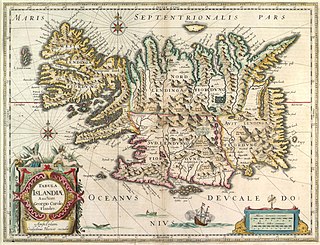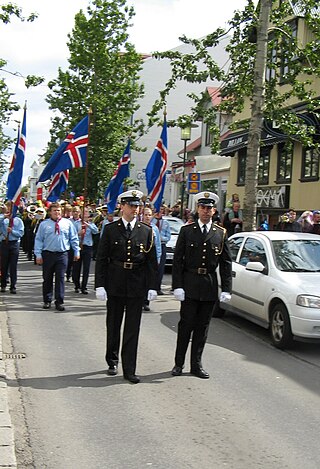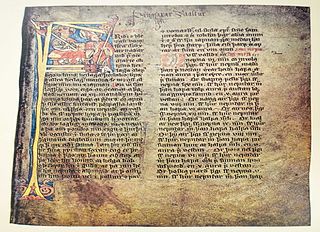
The recorded history of Iceland began with the settlement by Viking explorers and the people they enslaved from Western Europe, particularly in modern-day Norway and the British Isles, in the late ninth century. Iceland was still uninhabited long after the rest of Western Europe had been settled. Recorded settlement has conventionally been dated back to 874, although archaeological evidence indicates Gaelic monks from Ireland, known as papar according to sagas, may have settled Iceland earlier.

The Alþingi, anglicised as Althingi or Althing, is the supreme national parliament of Iceland. It is the oldest surviving parliaments in the world. The Althing was founded in 930 at Þingvellir, about 45 kilometres (28 mi) east of what later became the country's capital, Reykjavík. After Iceland's union with Norway in 1262, the Althing lost its legislative power, which was not restored until 1904 when Iceland gained home rule from Denmark. For 641 years, the Althing did not serve as the parliament of Iceland; ultimate power rested with the Norwegian, and subsequently the Danish throne. Even after Iceland's union with Norway in 1262, the Althing still held its sessions at Þingvellir until 1800, when it was discontinued. It was restored in 1844 by royal decree and moved to Reykjavík. The restored unicameral legislature first came together in 1845 and after 1874 operated in two chambers with an additional third chamber taking on a greater role as the decades passed until 1991 when Althing became once again unicameral. The present parliament building, the Alþingishús, was built in 1881, made of hewn Icelandic stone. The unicameral parliament has 63 members, and is elected every four years based on party-list proportional representation. The current speaker of the Althing is Birgir Ármannsson.

Sveinn Björnsson was the first president of Iceland (1944–1952).

This is a list of heads of state of Iceland, including Kings of Norway from 1262 to 1814, Kings of Denmark from 1814 to 1918, the King of Iceland from 1918 to 1944 and Presidents of Iceland from 1944.

Hannes Þórður Pétursson Hafstein was an Icelandic politician and poet. In 1904 he became the first Icelander to be appointed to the Danish Cabinet as the minister for Iceland in the Cabinet of Deuntzer and was – unlike the previous minister for Iceland Peter Adler Alberti – responsible to the Icelandic Althing.

Jón Sigurðsson was the leader of the 19th century Icelandic independence movement.

Stefán Jóhann Stefánsson was the first actual minister of Foreign Affairs in Iceland from 18 November 1941 to 17 January 1942. He was prime minister of Iceland from 4 February 1947 to 6 December 1949. He was first elected to the Althing in 1934 but did not get reelected in 1937. From 1942 to 1953, he regained his seat in the Althing. He was chairman of the now defunct Social Democratic Party (Alþýðuflokkurinn) from 1938 to 1952. He was ambassador of Iceland in Denmark from 1957 to 1965. He was minister for social affairs from 1939 to 1941 and Minister of Foreign and Social Affairs from 1941 to 1942. He was Prime-Minister when Iceland joined NATO in 1949; leading a coalition consisting of his own Social Democratic Party together with the Independence Party and Progressive Party.
The Constitution of Iceland is the supreme law of Iceland. It is composed of 80 articles in seven sections, and within it the leadership arrangement of the country is determined and the human rights of its citizens are preserved. The current constitution was first instituted on 17 June 1944 when Iceland became a republic; since then, it has been amended seven times.

Icelandic National Day is an annual holiday in Iceland which commemorates the foundation of The Republic of Iceland on 17 June 1944. This date also marks the end of Iceland's centuries-old ties with Denmark. The date was chosen to coincide with the birthday of Jón Sigurðsson, a major figure of Icelandic culture and the leader of the 19th-century Icelandic independence movement.

The anti-NATO riot in Iceland of 30 March 1949 was prompted by the decision of the Alþingi, the Icelandic parliament, to join the newly formed NATO, thereby involving Iceland directly in the Cold War, opposing the Soviet Union and re-militarizing the country.

The British invasion of Iceland by the United Kingdom's Royal Navy and Royal Marines occurred on 10 May 1940, during World War II. The invasion took place because the British government feared that Iceland would be used militarily by Nazi Germany, which had overrun Denmark a month earlier. Although Iceland was independently governed, it was in a personal union with Denmark, which was largely responsible for its foreign relations. The Government of Iceland issued a protest, charging that its neutrality had been "flagrantly violated" and "its independence infringed".
A constitutional referendum was held in Iceland between 20 and 23 May 1944. The 1918 Danish–Icelandic Act of Union declared Iceland to be a sovereign state separate from Denmark, but maintained the two countries in a personal union, with the king of Denmark also being the king of Iceland. In the two-part referendum, voters were asked whether the union with Denmark should be abolished, and whether to adopt a new republican constitution. Both measures were approved, each with more than 98% in favour. Voter turnout was 98% overall, and 100% in two constituencies, Seyðisfjörður and Vestur-Skaftafjellssýsla.

Law of Iceland during the Commonwealth (930–1262) was decided by the Alþingi (Althing). It has changed over the years, but the legislative body is still called the Althing.

The Occupation of Iceland during World War II began with a British invasion intent on occupying and denying Iceland to Germany. The military operation codenamed Operation Fork was conducted by the Royal Navy and Royal Marines. In time, the British forces were replaced by Canadian and later American forces, despite that the United States was not yet in the war.

At the beginning of World War II, Iceland was a sovereign kingdom in personal union with Denmark, with King Christian X as head of state. Iceland officially remained neutral throughout World War II. However, the British invaded Iceland on 10 May 1940. On 7 July 1941, the defence of Iceland was transferred from Britain to the United States, which was still a neutral country until five months later. On 17 June 1944, Iceland dissolved its union with Denmark and the Danish monarchy and declared itself a republic, which it remains to this day.

Icelandic–British relations are foreign relations between Iceland and the United Kingdom.

The Icelandic independence movement was the collective effort made by Icelanders to achieve self-determination and independence from the Kingdom of Denmark throughout the 19th and early 20th century.

Throughout the Cold War, the nation of Iceland was a member of the North Atlantic Treaty Organization (NATO) and allied with the United States, hosting a US military presence in Keflavík Air Base from 1951 to 2006.

The Danish–Icelandic Act of Union, an agreement signed by Iceland and Denmark on 1 December 1918, recognized Iceland as a fully independent and sovereign state, known as the Kingdom of Iceland, which was freely associated to Denmark in a personal union with the Danish king. Iceland established its own flag, declared its neutrality and asked Denmark to represent on its behalf foreign affairs and defence interests, while maintaining full control of them. Iceland opened its first embassy in 1920. The Act would be up for revision in 1940 and could be revoked three years later if agreement was not reached.
The following is a timeline of the history of the city of Reykjavík, Iceland.
























